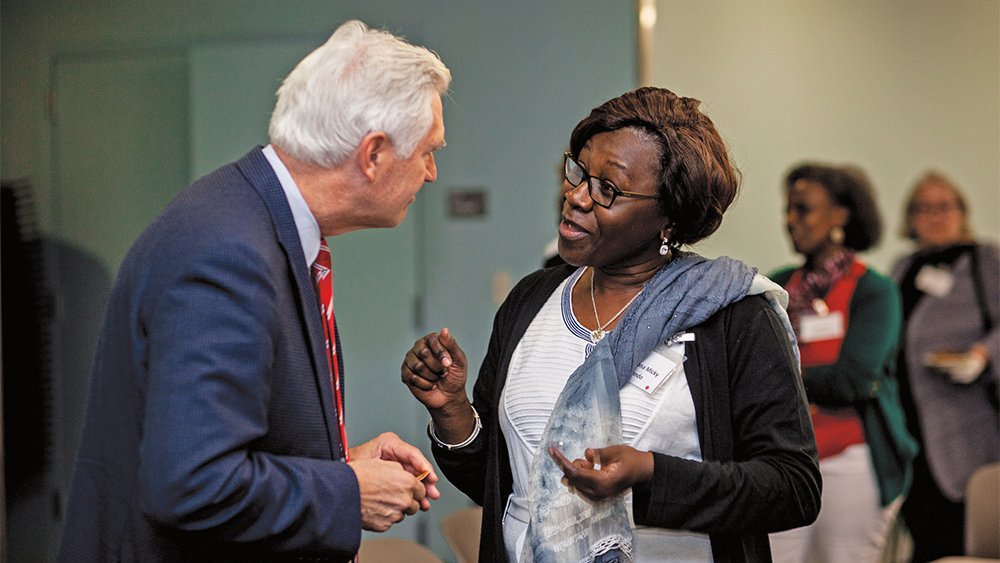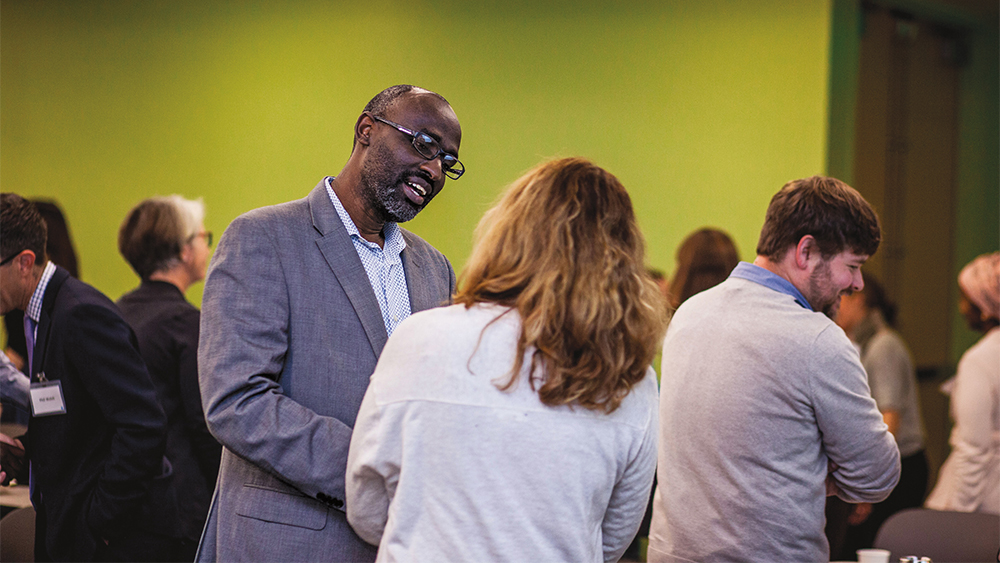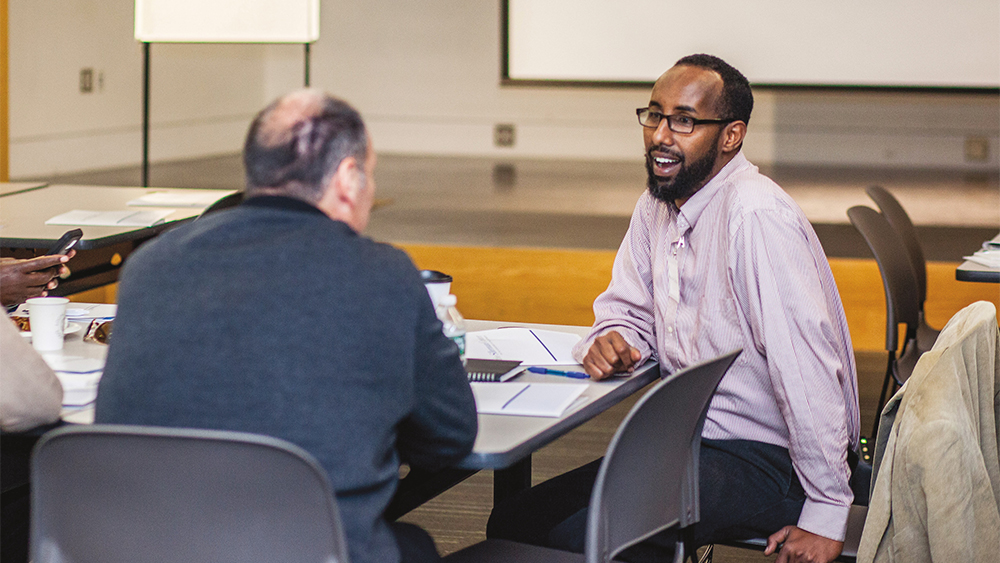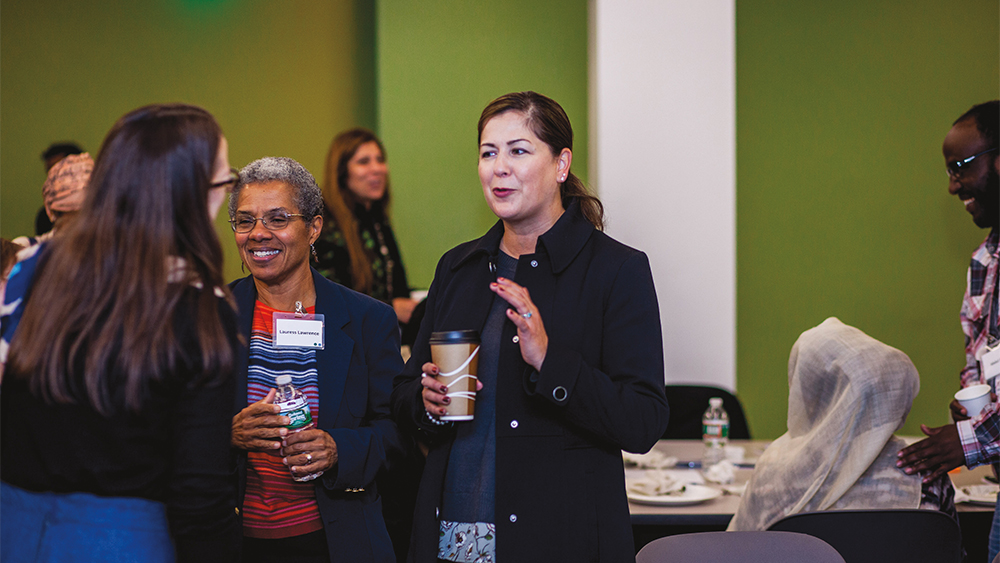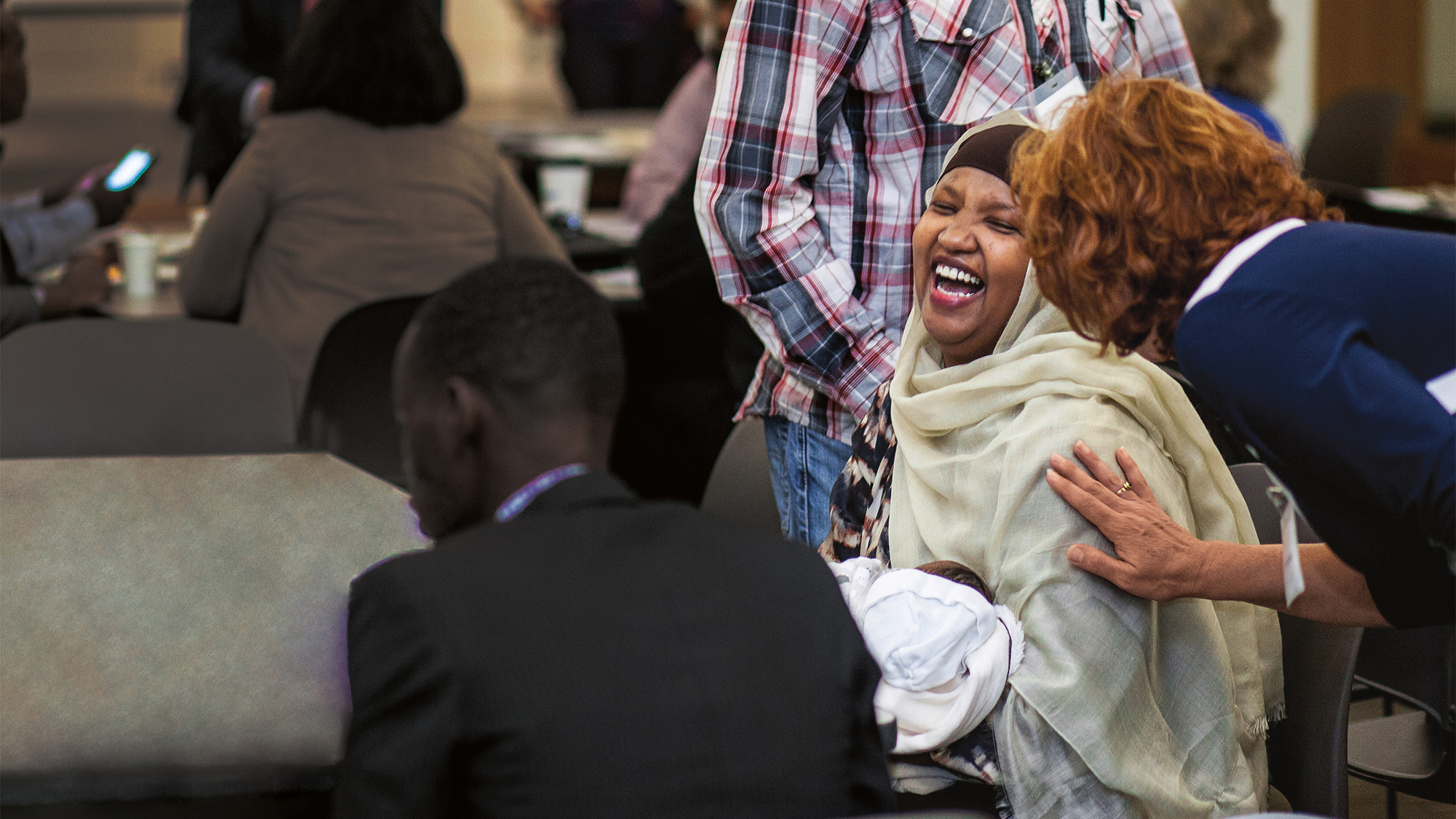
By Bethany Romano, MBA'17
Few issues are as polemical in the U.S. today as immigration. While communities across the nation struggle to keep up with a rapidly changing policy environment, faculty members and staff at the Sillerman Center for the Advancement of Philanthropy are bringing together funders and immigrant-led organizations across three states to promote immigrant integration efforts on the ground.
Together, they are building bridges and improving the funding landscape in northern New England, which is undergoing rapid demographic change.
A few weeks prior to the 2016 presidential election, Megan Briggs Reilly, MBA’03, drove north from Boston to Portland, Maine, to attend a meeting convened by the Sillerman Center for the Advancement of Philanthropy.
As the New England program officer for the Clowes Fund, a family fund supporting the arts, education and social services, Reilly joined representatives from other foundations in the region, as well as dozens of leaders of immigrant-led nonprofit organizations. Their common goal was to promote immigrant integration work in the state — but the tone and format of the event was strikingly different from what she was used to.
“Usually at events like these, the funders are sitting on a stage and the nonprofit reps are taking notes in the audience, trying to ‘crack the code’ of how to get funding. Instead, we were seated together, talking frankly about the power dynamics between funders and grantees, how funders can better support immigrant leaders in their work, how to have more authentic conversations with one another and how to work better together to support immigrant integration in the region,” explains Reilly.
“I remember I was seated at a table next to a gentleman who is the leader of Maine Immigrant and Refugee Services, located in Lewiston,” she says. “We had a conversation and exchanged cards, and a few months later he called me — and he later became one of our grantees.”
Social Justice Philanthropy
“The Sillerman Center’s mission,” says director Susan Eaton, “is to inform and to advance social justice philanthropy. What that means is that we try to get funders to invest more resources in social justice challenges that are often neglected or politically difficult.” At Sillerman, Eaton explains, “We encourage funding strategies that hack away at the root causes of a problem and try to build funder knowledge about remedies that have a supportive research base or existence proofs on the ground.
“It’s always seemed to me that immigrant integration fits this description,” she adds. “It’s both a misunderstood and a somewhat neglected funding area among philanthropists.”
In general, Eaton notes, philanthropic dollars tend to go to immigration crises and to federal immigration-reform efforts. “There’s less attention paid to what actually happens to immigrants when they get to their new communities, what happens in communities when demographics are changing, and how communities can adjust policies and practices so that everyone can thrive.”
In her eyes, funders aren’t seizing these grant-making opportunities. This was true in the northern New England states of Maine, New Hampshire and Vermont, she says. But she also knew there were a few funders there, including Reilly at the Clowes Fund and staff at the Endowment for Health in New Hampshire, who’d taken the lead on these often controversial topics. In 2014, the Endowment for Health had developed a nationally recognized, place-based model for immigrant integration. With additional investments from the nh Charitable Foundation and the United Way of Nashua, this project convened and supported four communities across New Hampshire as they designed and implemented their own immigrant-integration initiatives.
“We felt that an organized learning partnership, which, in part, would elevate and showcase these funders’ ongoing work, could be catalytic, leading to more interest and more resources for immigrant integration,” Eaton says. The goal was to build on existing efforts in each of the three states, and create a broader regional focus and network to strengthen the work of immigrant-led organizations and their allies.
“There’s this assumption that ‘there aren’t any immigrants up there,’” says Eaton, “which isn’t true. But because of that narrative, and because these have been white-dominated spaces for so long, it’s necessary to bring steady, deliberate attention to the need for immigrant integration there.”
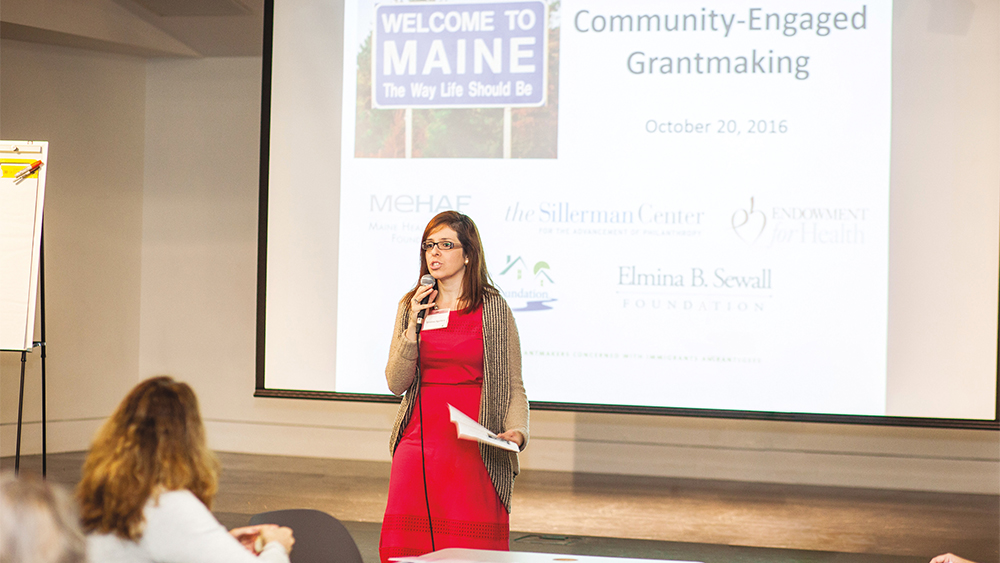
In 2016, Sillerman’s Immigrant Integration in Northern New England project co-directors, Cristina Aguilera Sandoval and Jessica Santos, PhD’15, pulled together a network of players in the field. Since 2014, Aguilera and Santos had been cofacilitators for the Endowment for Health’s New Hampshire community of practice on immigrant integration. They built off their existing networks in N.H. to host the first regional convening in June 2016, followed by a convening in Maine in October 2016.
They brought funders together with ethnic leaders and immigrant-led integration nonprofits of all sizes to talk about the challenges and opportunities in the region. For some attendees, it was the first time they’d been in a space shared by both grantees and funders all exploring issues of mutual concern. Convening attendees reported later in evaluations that such conversations, if they happened at all, usually only occurred in the context of funding requests.
For Aguilera, facilitating this change work means strengthening entire communities. “I think that when you’re focused on opening hearts and minds, and connecting people to build understanding about each other’s culture, the values that they share and the differences they have — can actually make a community stronger,” she says. “When funders focus on supporting the groups that are bringing together immigrants and non-immigrants, they can mitigate some of the resistance to change that every human being has in their nature. That natural resistance to change can morph into hateful reactions based on fear. Integration work acknowledges that fear and helps to increase welcoming reactions.”
Immigrant Integration in a Changing Northern New England
Immigration has been a contested topic for decades. But it moved to center stage during the presidential campaign and subsequent election of Donald Trump. In just under two years, his administration has introduced a travel ban on mostly Muslim-majority nations, scaled back the refugee program, revoked DACA protections and separated thousands of families at the U.S.-Mexico border.
In light of this new policy environment, Santos describes a climate of intense fear among many immigrants in northern New England. She says, “People are being deported. There are sometimes checkpoints along Interstate 93 in New Hampshire. In northern Vermont, immigrant farm workers are afraid to leave the farms they work on because they’re within the 100-mile border zone with Canada.”
Santos, who is the director of community-engaged research at the Institute on Assets and Social Policy at Heller, says that debates around immigration are really debates about power, “othering” and about who is American.
Eaton illustrates, “For example, crossing the border illegally is a civil infraction, not a criminal one. But it is being criminalized today, and that is allowed to happen through a process of othering.” Narratives like these, she says, further the ethnocentric narrative that the only acceptable immigrants are those who don’t integrate, but assimilate.
The difference between assimilation and integration is key. “Assimilation is the idea that immigrants should adopt the culture of white, mainstream Americans. Integration, on the other hand, is a process whereby everyone in a community changes as a result of demographic change,” says Santos.
“Demographic shifts like immigration force everyone — both newcomers and long-standing community members — to think differently and work together to create the community they want. That means sharing power,” she adds. Sillerman’s approach promotes shared power not just in communities and among neighbors, but between the funders, community leaders and staff of nonprofit organizations.
When people think about immigration in the United States, states like New Hampshire, Vermont and Maine rarely come to mind. In fact, much of the integration field has been built around urban centers, posing unique challenges to organizations in these largely rural states.
That common misperception ignores established immigrant communities from Europe and Canada as well as newer immigrant populations from Latin America, Africa and Asia. A big part of the work that Aguilera and Santos do with funders is to educate them on the changing demographics of this region.
In fact, immigrants and refugees are critically important in stabilizing the workforce in these states, which are in desperate need of new working-age residents. The native-born population of northern New England is aging rapidly, and many young adults are leaving the region altogether, which results in flat or declining population figures. At 43.5 years, Maine has the highest average age of any state, immediately followed by Vermont at 42 and New Hampshire at 41.5.
In New Hampshire, the arrival of new immigrants and refugees offsets otherwise negative population growth. Vermont made headlines this year with the announcement that it would pay people $10,000 just to move there if they work remotely for an out-of-state company. In addition to bolstering these states’ economies as workers and taxpayers, immigrants are responding to the region’s growing need for skilled caregivers to the skyrocketing population of elderly residents.
Building stable communities and promoting immigrant integration is crucial if northern New England is to remain a comfortable, safe place to live, work and raise families.
Leveraging New Networks
As funders and immigrant-led community organizations learned of the Sillerman Center’s work, the network expanded dramatically. From the start, the Sillerman team partnered with Grantmakers Concerned with Immigrants and Refugees (GCIR), a national network of foundations that fund in the immigration space.
“Sillerman has filled a role of convening foundations in this region in a way where there was nobody else to do it,” says Reilly of the Clowes Fund, who has stayed involved since her initial experience in Portland two years ago. “The work that Jess and Cristina have done to organize these meetings, to be able to come together and participate and talk about immigration in northern New England, is incredible. Everyone I’ve talked to has been thankful.”
In addition to educating funders on demographic change and creating a network around immigrant integration in the region, Sillerman invites foundations to re-examine how traditional power dynamics have constrained their grantmaking practices and to develop alternatives to the usual way of doing business.
Aguilera says, “Many funders in this area are now looking into how to better support the ethnic-led organizations that are doing the work in the community. They’re finding ways to do more equitable grant making. They are reconsidering who they haven’t given grants to before, and why. They’re rethinking how they choose their grantees in a way that’s based not only on what their grant writing describes but on what their work on the ground looks like firsthand. They’re changing their systems so that young, ethnic-led organizations can compete with big 20-year-old organizations for funding.”
To Aguilera, this ongoing project provides a way for culturally and racially diverse communities to work through that change in ways that benefit everyone. She says, “I’m passionate about the opportunities that this work can create for entire communities, and the changes that can happen when you convene people from different cultures and backgrounds and bring them together with resources to build relationships and create a shared vision of what they need to thrive as a community.
“There’s something really powerful about building welcoming places.”
Interested in getting involved with immigrant integration efforts, as a volunteer or as a funder? Contact Cristina Aguilera Sandoval (caguilera@brandeis.edu). Access resources and learn more about the Sillerman Center's ongoing immigrant integration work here.


